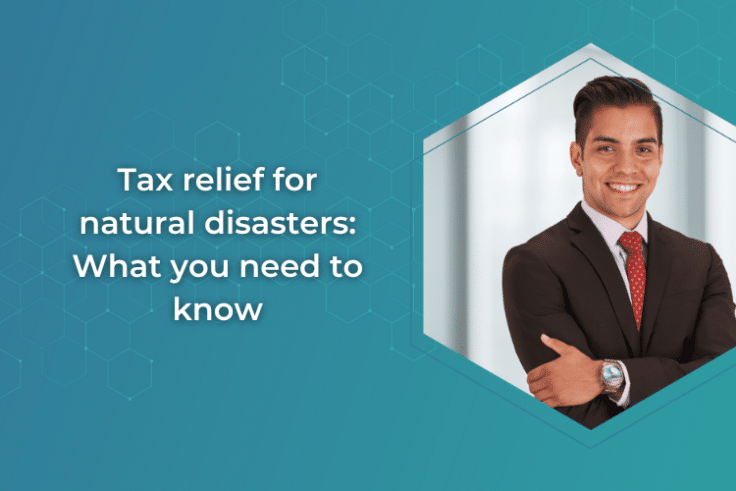
Natural disasters that once seemed predictable and confined to certain regions are now striking everywhere. Property owners face questions of preparedness and recovery in communities that always seemed safe. While disaster victims turn to the Federal Emergency Management Agency (FEMA) and state agencies for assistance, they can also find a friend in the IRS.
Under U.S. tax laws, property owners may qualify for tax relief for natural disasters, faster refunds and filing extensions — especially if the federal government declares their region a major disaster area.
For tax preparers, here’s everything you need to know about natural disaster tax relief, what qualifies for disaster tax relief and how your clients can recover financially and move on with their lives.
What types of natural disasters qualify for tax relief?
When it comes to tax relief for natural disasters, filers may deduct casualty losses relating to homes, household items and vehicles on their federal income tax return if a federally declared disaster causes the loss.
According to the IRS, a casualty loss “can result from the damage, destruction or loss of your property from any sudden, unexpected or unusual event such as a flood, hurricane, tornado, fire, earthquake or volcanic eruption.”
Other casualty losses can result from:
- Car accidents
- Government-ordered demolition or relocation of homes made unsafe by disaster
- Mine cave-ins
- Shipwrecks
- Sonic booms
- Terrorist attacks
- Vandalism
It’s important to note that “casualty” doesn’t include normal wear and tear or deterioration over time. For instance, a homeowner could have qualified for natural disaster tax relief due to the sudden and unexpected damage caused by Hurricane Harvey, but deterioration caused by the constant beating of Gulf winds doesn’t count.
How to qualify for natural disaster tax relief
Under natural disaster tax relief acts passed by Congress in recent years, tax relief is available for losses incurred by federally declared disasters in tax years 2018 through 2025. Federally declared disasters are events authorized by the U.S. president and allow the flow of federal disaster assistance to an affected area.
Naturally, there are conditions:
- Filers must subtract $100 from losses involving “personal-use property” — the items used for personal enjoyment instead of business or investment purposes, such as appliances, art, light fixtures or personal vehicles.
- After totaling casualty losses for the year, subtract 10% of adjusted gross income.
When part of a property is destroyed, the loss is considered the smaller of two amounts:
- Adjusted basis: Usually, this is the amount paid for the property before the disaster. It increases over time with additions and improvements while decreasing due to depreciation. The basis determination on properties acquired as a gift or inheritance can differ.
- Decline in fair market value: This scenario accounts for the impact of the disaster on the property’s fair market value (FMV). The FMV is the price the property could claim on the open market. The decline amount is calculated by value before and after the disaster, so a property once valued at $500,000 but now worth $350,000 has a decline in fair market value of $150,000.
Both figures are then further reduced by subtracting any insurance or reimbursement received or expected.
When to file for natural disaster tax relief
Taxpayers have choices when it comes to filing for natural disaster tax relief. They can claim a loss on the tax return for the disaster year or the year before the disaster.
Claiming a loss in the prior year can be done using Form 1040-X to amend that year’s return, possibly reducing that tax bill and generating a refund.
Filers who choose to claim the loss on the previous year’s return have six months from the original due date to amend the return and deduct the loss.
How to claim natural disaster tax relief
Losses qualifying for natural disaster tax relief are reported on IRS Form 4864, Casualties and Thefts. Publication 584 is the IRS workbook for calculating losses on personal-use property, while 584-B guides business owners through the same process.
Taxpayers with home addresses in the federally declared disaster area automatically receive extra time to file their tax returns and make final tax payments. Filers who live outside a disaster area also qualify for a postponement if their tax preparers are within the disaster-area boundaries and can’t file or pay taxes on the client’s behalf. Those taxpayers can claim relief by calling the IRS Disaster Hotline at 866-562-5227. You must provide the FEMA disaster number of the area where the tax preparer lives.
Business entities, sole proprietorships and shareholders of S corporations with tax records located in the disaster area may also qualify for extensions.
Taxpayers forced to relocate by a disaster should update their addresses with the IRS by filing Form 8822. If their tax records have been destroyed, they can get free transcripts using the IRS Get Transcript tool. The IRS advises being prepared by creating backup documentation and photographing personal property before disaster strikes.
Help your clients claim natural disaster tax relief
No one ever wants to seek tax relief for natural disasters, but a tax preparer equipped to provide sound guidance can be a blessing when the need arises. The ability to extend tax deadlines and receive speedy natural disaster tax relief helps lift at least one worry from homeowners and businesspeople dealing with emotional losses and trying to navigate a maze of assistance programs and contractors.
In an age when disaster can strike at any time, the tax preparer ready to answer questions on the spot provides an invaluable service. The timeliness of Surgent Income Tax School’s CPE courses equips tax preparers to ably manage their clients’ everyday tax affairs and be there when emergency strikes. The comprehensive Guide to Start and Grow Your Successful Tax Business provides step-by-step guidance on turning tax preparation into a thriving enterprise with the capacity to help clients weather their tax challenges year-round.
